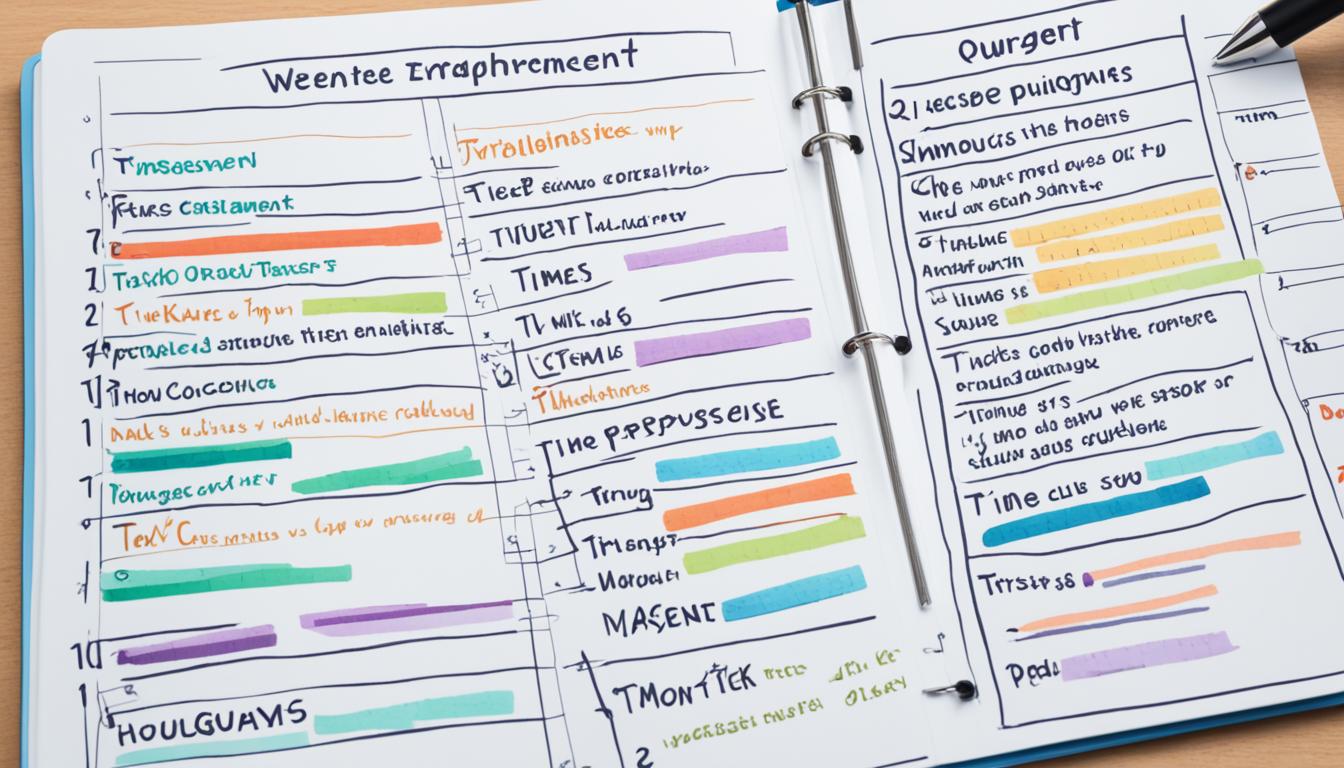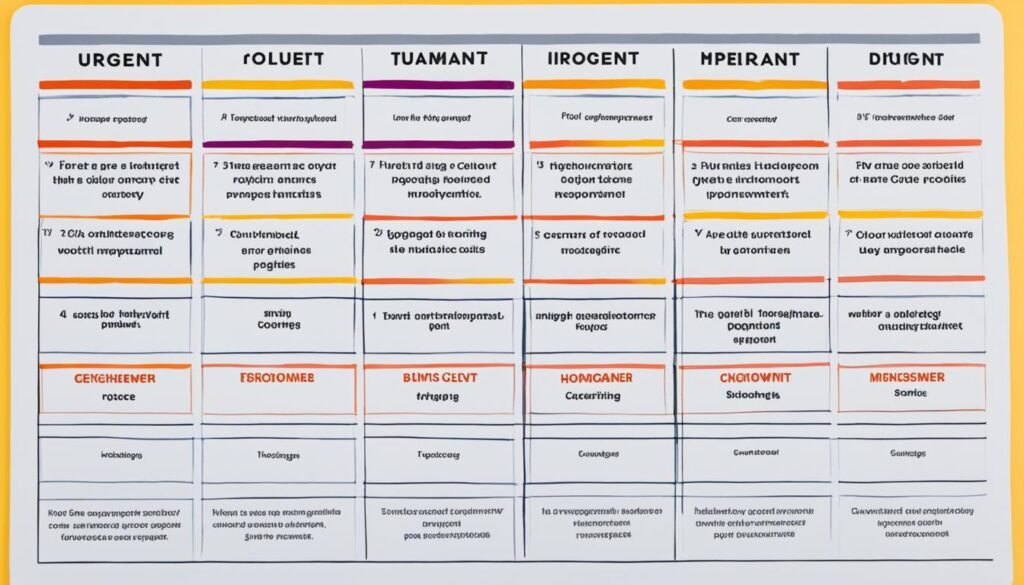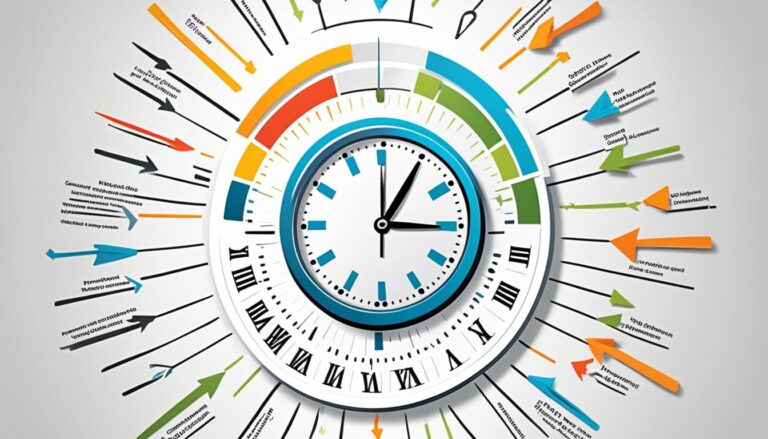Master Prioritizing Time Management Successfully

“Time management is the key to unlocking your full potential and achieving your goals.” – Brian Tracy
In today’s fast-paced world, effective time management has become a critical skill. Whether you are a microbusiness owner juggling multiple responsibilities or a solopreneur striving to make every minute count, prioritizing time management is essential for maximizing productivity and achieving success.
Properly managing your time not only leads to better work quality but also reduces stress, provides more time for strategic projects, minimizes procrastination, and boosts self-confidence. By mastering the art of prioritizing time management, you can unlock your full potential and transform your productivity.
Key Takeaways:
- Effective time management leads to better work quality, reduced stress, and increased productivity.
- Understanding how you spend your time is the first step towards effective time management.
- Create a daily schedule with specific time blocks to optimize your productivity.
- Prioritize tasks using the Eisenhower Matrix to focus on what truly matters.
- Tackle the most difficult task first to overcome procrastination and distractions.
Understanding How You Spend Your Time
To effectively manage your time, it’s crucial to gain a clear understanding of how you currently allocate your hours. By tracking your time, you can identify where precious minutes slip away and discover opportunities for improvement. Utilize time-tracking tools like RescueTime to monitor your activities and analyze your productivity patterns.
Image:
![]()
Tracking your time allows you to identify any habits or activities that hinder your productivity. It helps you distinguish between truly valuable work and time-consuming tasks that yield little progress. You’ll gain insights into the amount of time you spend on non-work-related activities, such as browsing social media or engaging in unrelated personal tasks.
With this newfound awareness, you can make necessary adjustments and allocate your time more effectively. Let’s examine the benefits of tracking your time:
1. Identify Time Drain:
Time-tracking reveals how much time you spend on different activities throughout the day. You can uncover pockets of unproductive time that you can repurpose for essential tasks. Discovering time drains empowers you to eliminate or minimize them, allowing you to focus on more meaningful work.
2. Maximize Productive Hours:
By analyzing your time-tracking data, you can determine when you are most productive. This information enables you to schedule your most important and challenging tasks during your peak concentration periods. As a result, you’ll make significant progress on critical work, achieving better outcomes in less time.
3. Balance Work and Personal Time:
Tracking your time provides insights into how much time you allocate to non-work-related activities. It helps you strike a healthy work-life balance by identifying excessive time spent on distractions or leisurely pursuits. This balance is crucial for your overall well-being and prevents burnout.
Remember, understanding where your time goes is the first step towards effective time management. By tracking your time and using the insights gained, you can optimize your productivity and make intentional choices that align with your goals.
Creating a Daily Schedule
Enhance your time management skills by creating a daily schedule that enables you to make the most of your time. Rather than having a vague idea of how much time you have for tasks, a structured schedule with specific time blocks for different activities allows for better planning and productivity.
When creating your daily schedule, it’s essential to set realistic timelines for each task. Consider the complexity and requirements of each activity, and allocate an appropriate amount of time accordingly. This will help you avoid overestimating or underestimating the time needed, contributing to more accurate planning and smoother execution.
Another valuable technique to incorporate into your daily schedule is the addition of time buffers. Unexpected delays can occur, which might disrupt the flow of your planned activities. By including buffers between tasks, you allow yourself some flexibility to handle unexpected situations without derailing your entire schedule.
However, creating a comprehensive schedule is not enough. It requires self-discipline to stick to the allocated time slots and resist distractions. During work hours, close unnecessary browser tabs, turn off notifications, and silence your phone to maintain focus and productivity.
Follow these guidelines to create an effective daily schedule that enables you to accomplish tasks efficiently. By incorporating realistic timelines, time buffers, and practicing self-discipline, you can maximize your productivity and achieve success in your daily endeavors.

| Benefits of Creating a Daily Schedule |
|---|
| 1. Better planning and organization of tasks |
| 2. Enhanced productivity and time management |
| 3. Reduced stress and increased focus |
| 4. Improved discipline and self-control |
Prioritizing Tasks Using the Eisenhower Matrix
A well-organized to-do list is an essential tool for effective time management. However, when you have a long list of tasks, it can be overwhelming to determine where to start. This is where the Eisenhower Matrix comes in handy. Developed by former U.S. President Dwight D. Eisenhower, this decision-making matrix helps you prioritize tasks based on their importance and urgency.
The Eisenhower Matrix involves dividing your to-do list into four quadrants:
- Urgent and Important: Tasks that require immediate attention and are crucial to your goals.
- Important but Not Urgent: Tasks that are significant but can be scheduled for later.
- Urgent but Not Important: Tasks that demand immediate action but do not contribute significantly to your goals. Consider delegating these tasks to others if possible.
- Not Urgent and Not Important: Tasks that are neither urgent nor important and can be eliminated from your to-do list.
By categorizing your tasks using the Eisenhower Matrix, you gain clarity on what needs your immediate attention, what can be scheduled, what can be delegated, and what can be eliminated. This helps you allocate your time and energy more efficiently, ensuring that you focus on high-priority tasks that align with your goals.
Example of an Eisenhower Matrix:
| Quadrant | Tasks |
|---|---|
| Urgent and Important | Prepare presentation for tomorrow’s meeting |
| Important but Not Urgent | Research new marketing strategies |
| Urgent but Not Important | Respond to non-critical emails |
| Not Urgent and Not Important | Scroll through social media |
The example above illustrates how tasks can be categorized using the Eisenhower Matrix. By focusing on tasks that fall under the “Urgent and Important” quadrant, you ensure that you are prioritizing tasks that have a direct impact on your goals and productivity.
By consistently using the Eisenhower Matrix, you can avoid getting overwhelmed by a long to-do list and make informed decisions about how to allocate your time effectively. Prioritizing tasks based on their importance and urgency empowers you to maximize your productivity and focus on what truly matters.

Tackling the Most Difficult Task First
When it comes to managing your time effectively and overcoming procrastination, one highly effective strategy is the Eat That Frog method. This method encourages you to tackle the most difficult and important task first before moving on to other things.
Procrastination often stems from our natural tendency to avoid challenging or unpleasant tasks. We tend to put them off, allowing distractions to take over our focus. However, by confronting and completing the most challenging task early in the day, you set yourself up for success.
By prioritizing the most difficult task, you eliminate the mental burden that comes with procrastination. This task is commonly referred to as the “frog” because, like Mark Twain famously said, “If it’s your job to eat a frog, it’s best to do it first thing in the morning.”
When you commit to tackling the most difficult task first, you eliminate the time wasted worrying about it throughout the day. This approach builds momentum and creates a sense of accomplishment, propelling you forward with increased energy and productivity.
Moreover, by focusing on the challenging task before engaging in other activities, you minimize distractions. Distractions can derail your progress and hinder your ability to complete important tasks. By eliminating potential distractions from the start and maintaining a clear focus, you maximize efficiency and achieve better results.
So, the next time you find yourself tempted to put off an important task, remember the Eat That Frog method. Embrace the challenge, conquer the difficult task, and set yourself up for a productive and successful day.
Batch-processing Similar Tasks
When it comes to managing your tasks efficiently and optimizing your productivity, batching similar tasks is a game-changer. By grouping similar tasks together and working on them as a batch, you can enhance your efficiency and accomplish more in less time.
One effective way to make the most of batch-processing is to schedule client meetings on specific days. By dedicating certain days solely to client meetings, you can minimize context switching and create a focused environment for client interactions.
Another example of batching tasks is allocating dedicated time for responding to emails. Instead of constantly checking your inbox throughout the day, set aside specific time slots to address all your emails in one go. This method not only saves time but also reduces the chances of getting distracted by incoming messages.
Additionally, consider batch-processing report generation at the start of the day. Rather than generating reports sporadically, designate a focused block of time to compile and generate all the necessary reports. This approach not only streamlines the process but also enables you to start your day with a productive burst of accomplishment.
Benefits of Batching Tasks
By utilizing the strategy of batching tasks, you can unlock several benefits that significantly improve your efficiency:
- Enhanced Focus: Working on similar tasks in a concentrated manner allows you to get into a flow state, enhancing your focus and productivity.
- Reduced Distractions: Batching tasks minimizes the interruptions caused by switching between different types of activities, enabling you to maintain a higher level of concentration.
- Streamlined Workflow: Grouping similar tasks together streamlines your workflow and eliminates unnecessary time spent transitioning between different types of work.
- Time Savings: By focusing on one type of task at a time, you can complete them more efficiently, ultimately saving time that can be allocated to other essential activities.
So, start embracing the power of batching tasks and witness the significant improvements it brings to your overall efficiency and productivity.

| Task | Batch-processing | Non-batch-processing |
|---|---|---|
| Client Meetings | Designated days for all client meetings | Scheduled randomly throughout the week |
| Email Responses | Dedicated time slots for addressing all emails | Constantly checking and responding to emails |
| Report Generation | Batch-generating reports at the start of the day | Generating reports sporadically |
Setting Reasonable Time Limits
According to Parkinson’s law, work expands to fill the time allotted to complete it. This phenomenon is all too familiar, leading to time wastage and decreased productivity. To combat this, it’s crucial to set reasonable time limits for tasks in order to effectively manage your time.
By giving yourself smaller windows to complete tasks, you create a sense of urgency and focus that can significantly improve your productivity. Setting specific deadlines helps prevent unnecessary time wastage and ensures that you complete tasks within a defined timeframe.
When setting time limits, it’s important to consider the complexity and significance of each task. Some tasks may require more time, while others can be accomplished within shorter periods. By assigning appropriate time limits based on task requirements, you can allocate your time and resources more efficiently.
Benefits of Setting Reasonable Time Limits:
- Increased focus and concentration
- Greater efficiency in task completion
- Improved prioritization and time management
- Enhanced productivity and goal achievement
- Reduced likelihood of procrastination
Enforcing time limits also encourages effective decision-making. When faced with a tight deadline, you’re forced to make choices quickly and efficiently, minimizing the tendency to overthink or get caught up in unnecessary details. This can lead to more decisive actions and faster progress towards your goals.
By setting reasonable time limits, you can harness the power of Parkinson’s law to your advantage. Instead of allowing work to expand endlessly, you create boundaries that compel you to work efficiently and effectively. Embracing this approach to time management can transform your productivity and help you achieve your goals with greater ease.
Conclusion
Mastering time management techniques is crucial for maximizing productivity, reducing stress, and achieving success. By implementing the strategies mentioned above and leveraging productivity and automation tools like Slack, Dropbox, and Google Calendar, you can streamline your work processes and improve time management.
Prioritizing tasks, managing time effectively, and staying organized are key to unlocking the secrets of prioritizing time management and transforming your productivity. With the right tools and strategies, you can take control of your time and accomplish more in less time.
Remember, time is your most valuable resource. By making conscious choices about how you spend it, you can increase your productivity and reduce stress. Embrace the power of time management and embark on a journey towards greater efficiency and success. Start implementing these techniques today and witness the positive impact they have on your work and personal life.





